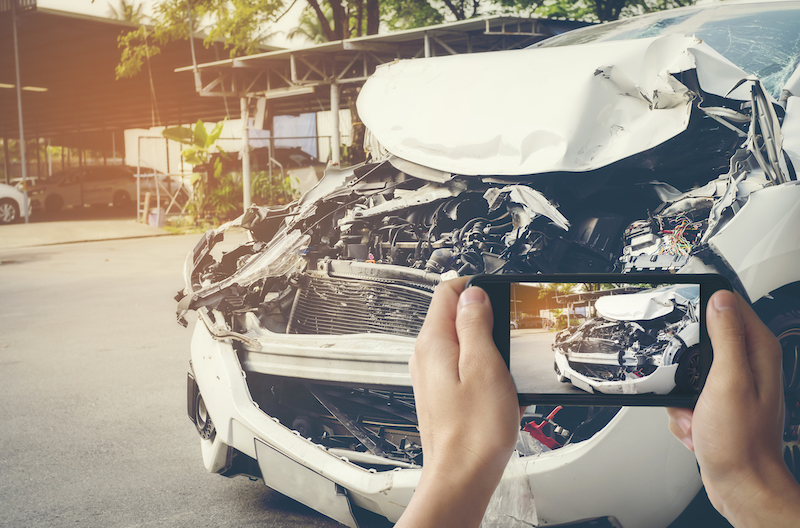Car accidents are traumatic and often leave victims feeling both disoriented and emotional after the crash. If you are involved in a car accident, your number one priority is to remain safe until emergency responders arrive. But, if you are able, the next best thing you can do is gather first-hand evidence while at the scene.
Why, exactly? If you are a victim of another driver’s negligence, you may be eligible for compensation that will help cover the costs for hospitalization and doctor’s visits, loss of wages if you have to take time off work to recover, and any physical and mental pain you suffer.
Were you or a loved one involved in a car accident that wasn’t your fault? Call Bart Durham Injury Law’s car accident attorneys 24/7 for a FREE consultation.
But, like all cases, you have to prove it with evidence; and the less evidence you have, the more difficult it is to make your case. Here are several tips when it comes to gathering evidence after a car wreck.
Proof of Medical Treatment, Medical Bills
Did you know that accepting medical care at the scene of a crash is a good idea? In fact, by refusing the care of emergency responders who arrive at the scene, insurance companies may use this as a reason to deny any injury claims you make related to the crash.
Even if you do not see any physical injuries or feel pain at the time of the crash, you could have suffered more injury than you realize. It may take a few hours – or even a few days – before you feel the effects. This is common due to the adrenaline rush your body experiences after a crash, which can make you unaware of hidden injuries your body has suffered (injuries to the neck, back, and brain, and even internal bleeding).
After accepting medical care at the scene of the accident, schedule a follow-up appointment with your primary care doctor as soon as possible for another evaluation. Not only will you be prioritizing your recovery by seeking treatment (medication, imaging tests, physical therapy), any medical records and medical bills you acquire immediately following the crash will give you more credibility and proof of your injuries.
Photos, Videos of the Accident Scene
It does not usually take long for an accident to be cleared and, simultaneously, the evidence at and around the scene to disappear. The scene of an accident offers many clues to personal injury lawyers and insurance adjusters: the weather conditions (low visibility), the roadway itself (an intersection, debris in the road, etc.), damage to the vehicles, and the final resting places of the vehicles.
Keeping your safety in-mind, take photos from wide-angles to show the wreck as a whole, including traffic signs or lights, skid marks on the road, and showing your car in relation to the other driver’s.
Take close-up photos, too, of damages to all the vehicles involved, as well as of yourself and any personal injuries that are already visible (cuts, wounds, etc.).
Also, a 1- to 2-minute-long video can give incredible context by preserving the scene for anyone who was not present.
All photos and videos you collect at the scene can be invaluable to building your case. At the same time, be respectful as you take photos and videos of the accident. Do NOT take photos of the other drivers without their consent and NEVER post anything about the accident on social media.
Police Reports
The officer responding to the scene of an accident is considered a trustworthy source by both insurance claims adjusters and lawyers alike when trying to determine fault after a car wreck. This is because the officer fills-out a police report with information such as the time and place of the incident, weather conditions, the drivers involved, and a diagram of the final resting places of the vehicles.
If a driver admits fault to the police officer, this also will be documented. (This could be as simple as the driver mentioning an illegal traffic maneuver they made, whether they realize it or not.)
You can request a copy of a police report in several ways. You can ask the officer directly, or you can call the police station and request the report (which may cost a small fee of $15-20).
Contact Information of Drivers and Witnesses
In some scenarios, the police officer responding to the scene may exchange your name, contact information, and insurance information with the other driver, and vice versa. If not, these are things you want to make sure you collect before parting ways. You will need to provide this information to your insurance company and personal injury attorney.
While it may seem unimportant at the time, the name(s) and contact information of anyone who witnessed the accident as it happened or immediately after can be the ace of spades when it comes to proving fault. This is especially the case if their statement mentions the other driver was at-fault.
Even though police officers typically collect witness testimonies, it can be difficult if not impossible for you to track them down for their testimony if you do not have their information.
If you are dealing with the pain and suffering of an injury suffered in an accident you did not cause, contact Bart Durham Injury Law for a FREE consultation about your situation.



